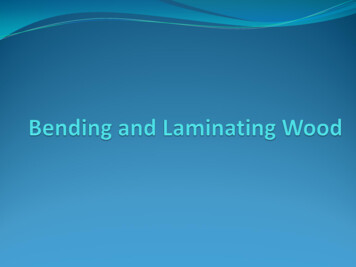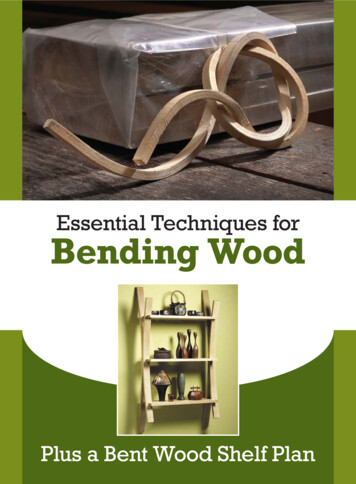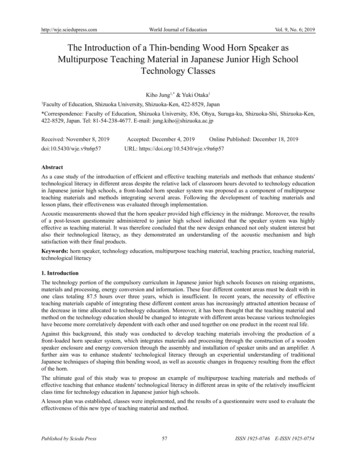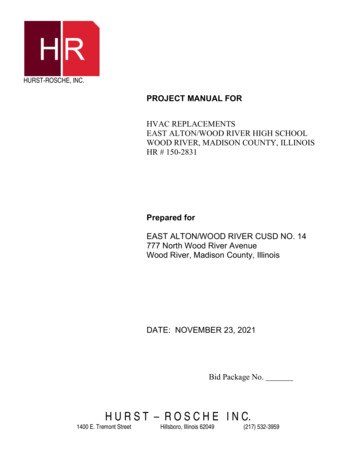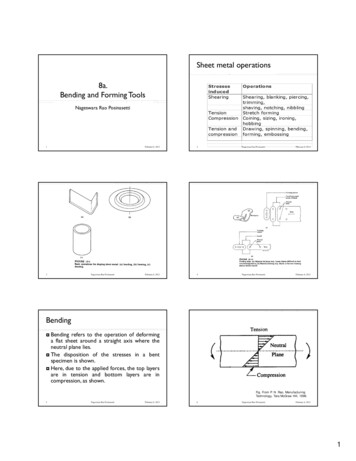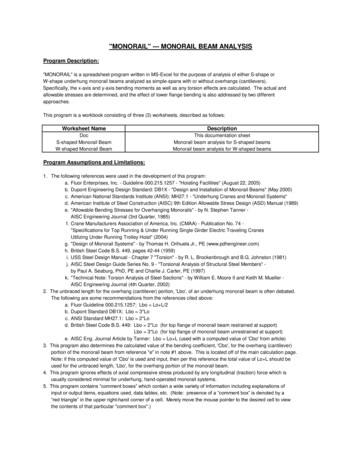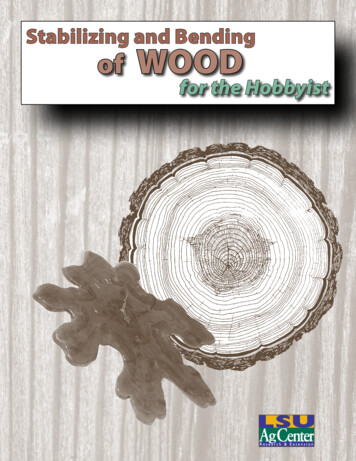
Transcription
Stabilizing and BendingofWOODfor the HobbyistPub. 2643 Stabilizing and Bending of Wood for the Hobbyist1
Table of ContentsIntroduction. . . . . . . . . . . . . . . . . . . . . . . . . 2PEG-1000 Chemical Treatment . . . . . . . . . . . . . . 3Salt Paste Method . . . . . . . . . . . . . . . . . . . . . . 5Drying Disks Without Chemical Treatment. . . . . . . 5Bending of Wood . . . . . . . . . . . . . . . . . . . . . . 7IntroductionLumber scraps and cross-sections of anglecuts sawed from small logs or large limbscan be made into attractive items, but onlyif the wood is first treated with polymersand then properly seasoned, or if the woodis initially seasoned following special techniques. These treatments and techniques canresult in profitable uses of “low grade” logsand oddly shaped scraps that might otherwisebe discarded. This publication describes sometechniques of stabilizing and bending woodfor hobbyists.2Pub. 2643 Stabilizing and Bending of Wood for the HobbyistFreshly cut cross-sections normally checkbadly and develop typical pie-shaped or vshaped cracks during the drying process. Thisis because wood shrinks twice as much in thetangential direction (parallel to the annualrings) as in the radial direction perpendicularto the annual rings). The internal stresses thatresult from such differential shrinkage invariably cause serious checks and splits as thewood loses moisture and comes to moisturecontent (MC) in a heated or air-conditionedwood shop. These are some of the techniquesfor drying wood cross-sections. These techniques can also be used for lumber scraps.
PEG-1000 Chemical TreatmentOne method recommended often in recentyears is stabilization of wood with a bulkingagent such as polyethylene glycol (PEG). PEGtreatment requires soaking the wood for a longtime. This tends to darken the sapwood. Also,PEG is hygroscopic and raises the MC of thewood; under humid conditions, the chemicalmay cause the finished board surface to developdiscolored streaks. To avoid these problems, youmust dry the disks without chemicals.Many hobbyists use PEG as a bulking agentthat greatly reduces the dimensional changes ofgreen wood. PEG is a white, wax-like chemicalthat resembles paraffin, is solid at room temperature, has an average molecular weight of 1000and dissolves readily in warm water. PEG meltsat 104 degrees Fahrenheit, is nontoxic, noncorrosive, odorless, colorless and has a very highfiring point (580 degrees Fahrenheit). It is chemically related to antifreeze.The PEG treatment, which physically bulksthe wood cell walls (fibers), prevents shrinkageand thus prevents the development of destructivestresses (figure 1.). Green wood heavily treatedwith PEG retains its “green dimensions” indefinitely, and thus is permanently restrained fromshrinking, swelling or warping, regardless ofhumidity changes.Figure 1. (Above) Unusual pieces should not automaticallybe discarded. (Below) This clock is an example of valueadded production of waste wood. The wood was treatedwith PEG and coated with polyurethane.Pub. 2643 Stabilizing and Bending of Wood for the Hobbyist3
3. Put fresh wood disks in solution: Stackwood with thin slats separating the pieces, sothat circulation of the solution is complete.Weight down the wood with a rock to assurecomplete immersion. Only green wood (withMC above the FSP or approximately 30% MC)can be treated effectively by the PEG method.The detailed treatment procedures are as follows:1. Choose a treating tank: This is used forsoaking the wood disks or slabs. It can be madeof glass or any nonmetallic substance. A largeplastic garbage can that has been lined with athick plastic bag can also be used for the soaking tank. The treating tank needs a cover to helpconserve heat and water. Some water will evaporate and change the concentration of the PEGsolution, but this will be balanced as the PEGis absorbed by the wood. It is also desirable tocover the sides, bottom, and especially the top,with fiberglass insulation to conserve heat.4. Heating: For faster results, equip treating tanks with electric heating elements (with abuilt-in thermostat) of the type used in a waterheater. A small pump may be used periodicallyto circulate the PEG solution. Hand-stirring willdo the job of the pump, but regularity is important.2. Preparing PEG solutions: Wood may besoaked in either a 30% or a 50% PEG solution.Soaking times are longer in the 30% solution.To prepare seven quarts of 30% solution, dissolve 4.46 pounds of PEG-1000 in five quarts ofwater. The specific gravity of the solution (at 60degrees Fahrenheit) will be 1.05. Check the specific gravity of the solution, using a hydrometerthat is similar to the one used to check the concentration of antifreeze in the radiator of a car.These solutions can be reused. Between uses,store them in glass containers. One to 2% boraxadded to the solution will prevent the growth ofsome bacteria and fungi, but not mildew and mold.5. Soaking time: This depends on solutionstrength and temperature, wood species andwood thickness. Table 1 shows the treating timenecessary for walnut disks to obtain the desired25% to 30% concentration of PEG in the finished product.Woods of lower density, such as soft maple,cottonwood, willow and pine, require only onehalf to two-thirds the time suggested for walnut.Heavy woods, such as hard maple, oak, apple,beech and birch, require a soaking time two orthree times longer than does walnut. Very hardwoods, such as mesquite and the burls of allspecies, must be treated at high temperatures forlonger periods.Table 1. Treatment schedule using PEG-1000.Solution strengthSoaking time for woodand temperatureup to 9 in. in diameter more than 9 in. in diameter(degrees Fahrenheit)and 1-1.5 in. thick4(Days)Soaking time for woodand 2-3 in. thick(Days)30%, (70)206030%, (140)73050%, (70)154550%, (140)314Pub. 2643 Stabilizing and Bending of Wood for the Hobbyist
Wood knots, cherry wood and the heartwoodof some species resist absorption of PEG andrequire special attention. For example, soakingcherry at a temperature above 110 degrees Fahrenheit will heart-check or honeycomb the wood.For treating 1-in. thick cherry disks, allow atleast 45 days in a 50% solution at or below 110degrees Fahrenheit.Soaking schedules for other types of woodcan be developed by experimentation. At first,soak the wood for the time recommended forwalnut. Then dry the wood in an oven at a temperature of about 200 degrees Fahrenheit. If nodefects develop, the soaking time is probablysufficient.6. Drying: Pile the treated wood using drystickers. The pile should be covered and kept ina well-ventilated room, preferably a heated area.PEG-treated wood cross-sections up to 4 inchesthick and 40 inches in diameter will dry in six toeight weeks if they are kept in a heated room atlow humidity. Treated wood kept outside must becompletely protected from water, and the dryingwill take somewhat longer than indoors. Sincetreated wood shrinks very little during drying, itis not necessary that the wood be completely drybefore you start working with it. It is only necessary that the top 1/4 inch of the surface be dryenough to sand well.7. Gluing: White glue or polyvinyl acetatedoes not work very well on PEG-treated wood.Only urea resins, epoxies and resorcinols aresatisfactory. For joints that require strength, asolvent should be used to cut the wax and exposethe wood fibers. The wood surface should bescrubbed and washed with alcohol.8. Finishing: PEG-treated wood may befinished after the surface of the wood has beensanded and shaped. Common single-componentpolyurethane varnishes give satisfactory results.Conventional wood finishes do not work wellon wood treated with PEG. If high MC createsproblems, use a base of four to five coats of themoisture-resistant polyurethane resin varnishes.Danish oil penetrating finish works well overPEG-treated wood, although many other oil-typeclear finishes cannot be used. The Danish oil finish can be used for PEG-treated bark.9. Treating defective pieces: Untreatedwooden objects purchased in other parts of thecountry may check and split badly when introduced to our air-conditioned and heated environment. When such defects are noted, soak thepiece in water and treat with PEG at once. If thechecks close completely, they will remain closed,and no further defects will develop.Salt Paste MethodThis is a simple and inexpensive way totreat a wood cross-section. The top and bottomof the green disk are alternately brushed witha concentrated table salt paste, then the disk isdried. To mix the salt paste, add three pounds ofsalt to one gallon of water. Mix thoroughly. Saltcrystals will be visible in the solution even aftermixing. Allow the solution to stand for severalhours, then mix in enough cornstarch to achievea pastelike consistency that will build up a thicklayer on the disk surfaces. Finally, mix in severalegg whites (this will reduce flaking of the pasteafter it dries) and apply the paste to both faces ofthe cross-sections. The salt paste should have theconsistency of oil paint or cake batter. Air drythe disks in a well-ventilated or heated room.Drying Disks Without ChemicalTreatmentNo method of drying large cross-sections ofwood will guarantee that cracks will not appear.The most common defect is large edge-to-center“V” cracks (figure 2). Also, disks will tend toshow many short cracks on the face parallel tothe wood rays. The rays in some species are visible and look like spokes in a wheel that originate in the center of the disk and extend out in aPub. 2643 Stabilizing and Bending of Wood for the Hobbyist5
3. Third Stage - Slow drying ata decreased rate is accomplished byplacing the disks in containers withtiny openings, such as plastic bags withsmall punctures. The room humidityshould be adjusted to 40% RH. In thecontainer, the evaporating moistureprovides the proper atmosphere with80% to 90% RH. Little vapor escapes,and the wood dries at a decreasing rate,reaching the MC of the room after fourweeks. While heaters can be used toraise the temperature and shorten thefinal stage, higher temperatures makeit more difficult to maintain the necessary humidity. The container shouldFigure 2. This cross-section of oak wood was improperly dried and hasdeveloped “V” cracks because of the different shrinkage rates of the wood. be insulated to prevent condensation atcool spots.“radial” manner to the bark. Sometimes cuttingthe slabs at an angle to the axis of the tree reduces the tendency of the disk to “V” check butwill not affect the potential of radial checks todevelop.One simple way of drying untreated 1-inchdisks involves three drying stages. Designed tominimize chances for the formation of checks,they are:1. First Stage - Tape plastic film over the inner section (heartwood) of each side of the greendisk. The outer portion (sapwood) of the sectionis allowed to dry to 30% MC at a relative humidity of 65% to 75%. This fast drying will avoiddiscoloration, stains and separation of the bark.About three to four days are needed. The plasticfilm will prevent heart checks.2. Second Stage - The pitch area can nowbe exposed to an environment of 75% to 80%relative humidity (RH) and allowed to begin todry. Let the MC of heartwood and sapwood bothdecrease to 25%. Maintain a moderate dryingrate to avoid surface checks. At least three daysare required for this stage.6Pub. 2643 Stabilizing and Bending of Wood for the HobbyistChemical-free drying can also be accomplished without plastic bags. The followingguidelines can help you and will reduce the likelihood of checking.1. Use temperature close to room temperaturefor the early stages of drying.2. Use high relative humidity in the earlystages of drying.3. Thin disks (2 in. or less) are less likely tocrack than thick disks, but tend to dish in drying.4. Thick disks dry very slowly (doublingthe thickness increases the drying time by 3-4times).5. Since the basic cause of the “V” crack isthe difference in radial and tangential shrinkageof wood, choosing a species with a low ratio oftangential (perpendicular to the rays)-to-radial(parallel to the rays) shrinkage will minimize thetendency to form a “V” crack. Mesquite is a domestic wood that offers these properties. Thereare also some foreign woods with similar radialand tangential shrinkage properties.
Bending of WoodWood bending is more of an art than a science. This ancient art is still of economic importance today because it is easier, faster, moreefficient and requires less expensive equipmentthan machining. The bending of wood is critical in the manufacture of some furniture items(figure 3), various tools and novelty items. Bentwood is usually stronger and stiffer than machined parts of equal dimension and requires lesssurface preparation for finishing.The two common methods to plasticize woodbefore it can be bent are by using steam and withliquid ammonia. Species that often bend wellusing either the steam or ammonia treatmentare the oaks, yellow-poplar, black cherry andsweetbay. For native Louisiana wood species,hackberry is probably one of the easier to bendby either method. Sweetgum, black gum, yellowpoplar and red maple often are difficult to bend.The bending behavior of any wood will dependon the species, treatment (steam or ammonia)and setting procedures. For any species to yieldgood bent wood structures, it must be knot anddecay free, contain no cross or twisted grain andnot be excessively low in density. Flat sawn lumber usually bends well. There is a great deal ofdisagreement concerning what moisture contentis best for bending wood, but most moisture contents reported by researchers are lessthan 25%. Steam-bent wood successdepends on steam time. It is somewhatweakened and may change its curvature with time, depending on exposureconditions and amount of restraintduring use.Figure 3. (Above) This is a classic chair produced withtypical wood bending. All pieces except the front legs arefrom bent wood. (Below) A restraining strap, center, followsthe convex side of this two-plane bend. An adjustable endpressure stop is controlled by the operator’s hand at lower left.Steam bending is often done atatmospheric pressure (212 degreesFahrenheit) or at gauge pressuresbelow 5 psi. Most Louisiana woodsneed only 45 minutes to be sufficientlyheated. The softening effect of ammonia is similar to that of steam, exceptPub. 2643 Stabilizing and Bending of Wood for the Hobbyist7
Figure 4. A hydraulic press is used to produce extreme bends in chairarms and some other furniture parts.that ammonia has better dissolving properties.The use of ammonia allows the hobbyist to makea variety of artistic, decorative and architecturalproducts.Bending can be done with and without (free)end pressure (figure 4). Free bending is satisfactory for mild bends. Bent wood will tendto return to its original form unless restraineduntil set. The setting of a bend is the oppositeof the plasticization of wood in that the wood isFigure 5. This bent ash wood has splits as a result ofinadequate end pressure.8Pub. 2643 Stabilizing and Bending of Wood for the Hobbyistnow cooled. A furniture maker will set the bendtogether while drying to the expected moisturecontent in service. The straps on the convex sideand end stops should be restrained during setting. The opening or distance between the endsof a bent piece should also be controlled. A splitcan occur if the end pressure is too high (figure 5).Figure 6. The process of bending wood is also used toproduce parts of a boat. The concave strap restrained bythe rods maintains end pressure and shape. The woodbraces reduce twisting. (Photo originally from USDA ForestService, Forest Products Laboratory, Madison, WI).
Wood bending is used to produce severalrecreational items. Among these are boat parts(figure 6) and tennis racquets and snow skies(figure 7).Figure 7. Wood bending is used to produce recreational items such asthese tennis racquets (right) and snow skis (left).Todd F. Shupe, Ph.D.Professor (Forest Products)Louisiana Forest Products Development CenterSchool of Renewable Natural ResourcesSource for all pictures: Peter Koch. 1985.Utilization of hardwoods growing on southernpine sites. USDA Agriculture Handbook 605. Vol II- Processing. U.S. Gov. Printing Office. Washington,DC.Acknowledgment: The author is grateful tothe assistance received from Dr. Chung Hse,Principal Wood Scientist, USDA Forest Service,Southern Research Station, Pineville, La.; Dr. PeterKoch, President, Wood Science Laboratory, Inc.,Corvallis, Mont.; Dr. Elvin Choong, Professor ofForestry, Louisiana State University AgriculturalCenter, School of Forestry, Wildlife, and Fisheries,Baton Rouge, La.; and Dr. Poo Chow, Professor ofWood Science, University of Illinois, DepartmentNatural Resources and Environmental Sciences,Urbana, Ill.Visit our website: www.LSUAgCenter.comLouisiana State University Agricultural CenterWilliam B. Richardson, ChancellorLouisiana Agricultural Experiment StationDavid J. Boethel, Vice Chancellor and DirectorLouisiana Cooperative Extension ServicePaul D. Coreil, Vice Chancellor and DirectorPub. 2943(Online only)12/10The LSU AgCenter is a statewide campusof the LSU System and provides equal opportunitiesin programs and employment.Pub. 2643 Stabilizing and Bending of Wood for the Hobbyist9
techniques of stabilizing and bending wood for hobbyists . Freshly cut cross-sections normally check badly and develop typical pie-shaped or v-shaped cracks during the drying process . This is because wood shrinks twice as much in the tangential direction (parallel to the annual rings) as in

